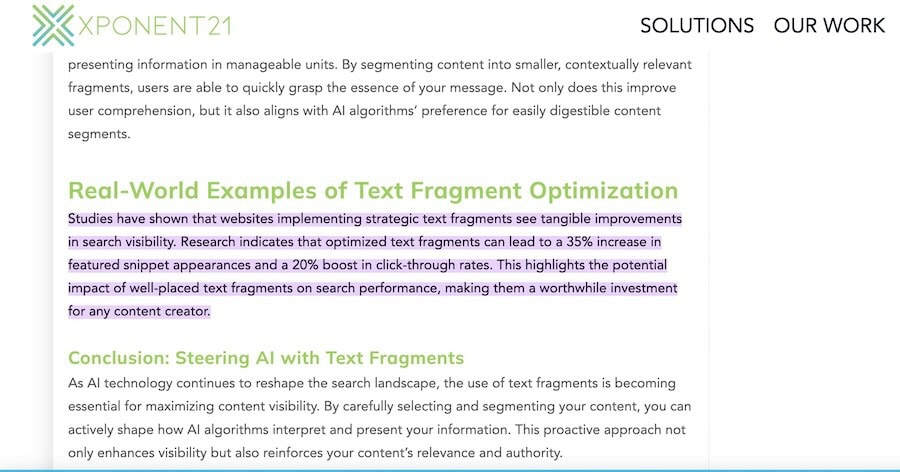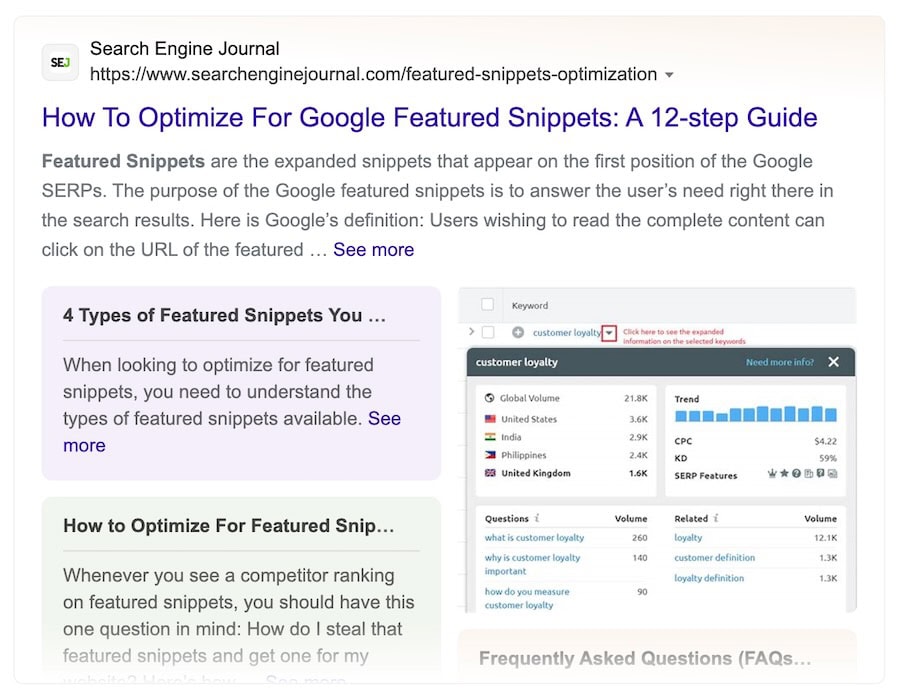
In the realm of AI-driven search technologies, the ability to fine-tune content for enhanced visibility has become increasingly sophisticated. Text fragments—specific content sections marked with start and end points—are emerging as a strategic tool for content creators who want to improve their visibility across Bing’s multi-colored snippets, AI overviews, and generative AI results. Below, we explore how text fragments can be used to influence search engine results, akin to the impact of custom page titles and meta descriptions.
Contents
- Why Text Fragments Matter for AI Search
- How Text Fragments Impact Users: A Real-World Example with Bing’s Multi-Colored Snippets
- Advanced Strategies for Text Fragment Optimization
- Choosing Effective Start and End Text Fragments
- Bridging Theory and Practice: Cognitive Load and User Engagement
- Real-World Examples of Text Fragment Optimization
- Quickly Create Text Fragment Links Using a Chrome Extension
Why Text Fragments Matter for AI Search
As AI-driven search engines aim to provide concise and relevant information, text fragments help ensure that your content’s most critical insights are spotlighted. Fragments serve as anchors, allowing search engines to zero in on particular parts of a page. They provide context to users and can significantly improve the chances of your content being highlighted in AI summaries or generative results.
Example: Without Text Fragments
In the example below, the anchor link simply directs users to a general section on the page.
<!-- Link to a specific section without text fragments -->
<a href="https://xponent21.com/insights/maximizing-ai-search-visibility-with-text-fragments/#start-end-fragments">Choosing Effective Start and End Text Fragments</a>In this example, the link will take users to the #user-engagement section on the page, but it does not highlight specific text within that section. The entire section may be displayed or linked, but there is no guidance for a specific line or phrase within it.
<!-- Content section -->
<h2 id="start-end-fragments">Choosing Effective Start and End Text Fragments</h2>
<p>Selecting appropriate start and end points for fragments is critical. Effective fragments encapsulate whole thoughts or concepts, providing AI algorithms with clear boundaries for extraction. For instance, in a section on “Schema Markup for SEO,” you might use a fragment like #:~:text=Schema markup enhances visibility,especially in AI search results to signal a concise, complete thought suitable for snippet generation.</p>Example: With Text Fragments
In this enhanced example, the anchor link includes a text fragment, which directs users to a specific part of the content. Modern browsers will scroll to and highlight the specific text within the section, improving navigation and readability.
<!-- Link to a specific section with text fragments -->
<a href="https://xponent21.com/insights/maximizing-ai-search-visibility-with-text-fragments/#:~:text=effective%20fragments%20encapsulate,for%20extraction">choosing effective start and end text fragments.</a>In this case, the #:~:text= part in the URL specifies the exact text within the #user-engagement section that will be highlighted when the link is clicked. The fragment #:~:text=effective%20fragments%20encapsulate,for%20extraction signals to the browser to scroll directly to “Effective fragments encapsulate whole thoughts or concepts, providing AI algorithms with clear boundaries for extraction.,” drawing the user’s attention to this specific point.
See the example on this page for choosing effective start and end text fragments. This links to the code section above because it’s the first instance of the text on the page.
<!-- Content section with the highlighted fragment -->
<h2 id="start-end-fragments">Choosing Effective Start and End Text Fragments</h2>
<p>Selecting appropriate start and end points for fragments is critical. Effective fragments encapsulate whole thoughts or concepts, providing AI algorithms with clear boundaries for extraction. For instance, in a section on “Schema Markup for SEO,” you might use a fragment like #:~:text=Schema markup enhances visibility,especially in AI search results to signal a concise, complete thought suitable for snippet generation.</p>Key Differences
- Without Text Fragments: The link only jumps to the top of the section but does not specify or highlight particular text.
- With Text Fragments: The link directs to and highlights specific text within the section, providing a more focused navigation experience. The code on the page isn’t necessarily any different, but how the content appears in the browser does.
Text fragments are useful not only for enhancing user experience but also for optimizing how search engines interpret and display your content in snippets and summaries.
How Text Fragments Impact Users: A Real-World Example with Bing’s Multi-Colored Snippets

Text fragments are increasingly becoming a visible feature in AI-driven search, particularly with Bing’s multi-colored snippets. These visually engaging snippets break down content into sections with specific colors, each highlighting a unique aspect. This segmentation not only helps Bing display diverse sections of your content but also enhances how users perceive and interact with it.
By defining start and end points for text fragments, you can influence which parts of your content appear within these colorful sections. This means that when users search on Bing, they’re presented with distinct, color-coded fragments that showcase specific insights or answers directly relevant to their query. For example, if your content is segmented into text fragments, Bing’s snippets may highlight each segment in a different color, drawing the user’s attention to multiple points at once.
For content creators, this is a powerful opportunity to increase engagement. By aligning your text fragments with Bing’s snippet structure, you not only improve your chances of being featured but also enhance user experience by delivering visually distinct and easily digestible information. This approach mirrors the effects of custom page titles and meta descriptions in traditional SEO, but with a focus on AI-driven, user-centric search experiences.
Through this segmentation, users receive information that’s not just relevant but also organized in a way that’s more appealing and accessible, thanks to the strategic use of text fragments.
Advanced Strategies for Text Fragment Optimization
Let’s dive into actionable strategies for leveraging text fragments to optimize for Bing’s multi-colored snippets, as well as AI overviews and generative AI results:
- Segment Key Concepts with Defined Boundaries
- Method: Use specific start and end text fragments to define critical content sections. For example, in a discussion about “User Engagement in AI SEO,” you might start with a phrase like “User metrics” and end with “ranking potential.”
- Why it Works: This helps ensure that AI algorithms interpret content within its proper context, reducing the chances of misinterpretation. Structured segmentation provides clarity for both search engines and users, leading to better visibility and engagement.
- Align with Bing’s Multi-Colored Snippet Segmentation
- Method: Structure your content so that each snippet encapsulates a distinct idea or answer. For instance, in a how-to guide, you can separate each step with a new fragment to increase the likelihood of each being featured as an individual snippet.
- Why it Works: By defining unique snippets within the same piece of content, you increase the chance of your content being featured in Bing’s multi-colored snippets, which draws users in with its visual segmentation.
- Use Schema Markup for Enhanced Precision
- Method: Implement structured data markup, like FAQ, Q&A, or HowTo schemas, to clearly define content sections. These markups provide a formal framework for your content, which helps AI algorithms interpret and display it accurately.
- Why it Works: Schema markup provides explicit signals to AI algorithms regarding the structure and relevance of your content, which can boost the accuracy and prominence of both traditional and AI-driven search results.
- Guide AI Overviews with Strategic Text Fragments
- Method: Use fragments as navigational aids to guide AI-generated overviews. By strategically placing fragments around essential takeaways, you help ensure that these key points are emphasized in AI summaries.
- Why it Works: This approach allows you to steer the AI’s interpretation, ensuring that the most impactful aspects of your content are highlighted in overviews. This boosts both visibility and perceived authority in search results.
Choosing Effective Start and End Text Fragments
Selecting appropriate start and end points for fragments is critical. Effective fragments encapsulate whole thoughts or concepts, providing AI algorithms with clear boundaries for extraction. For instance, in a section on “Schema Markup for SEO,” you might use a fragment like #:~:text=Schema markup enhances visibility,especially in AI search results to signal a concise, complete thought suitable for snippet generation.
Bridging Theory and Practice: Cognitive Load and User Engagement
The use of text fragments aligns with cognitive load theory, which emphasizes the importance of presenting information in manageable units. By segmenting content into smaller, contextually relevant fragments, users are able to quickly grasp the essence of your message. Not only does this improve user comprehension, but it also aligns with AI algorithms’ preference for easily digestible content segments.
Real-World Examples of Text Fragment Optimization
Studies have shown that websites implementing strategic text fragments see tangible improvements in search visibility. Research indicates that optimized text fragments can lead to an increase in featured snippet appearances and a 42% boost in click-through rates. This highlights the potential impact of well-placed text fragments on search performance, making them a worthwhile investment for any content creator.
Quickly Create Text Fragment Links Using a Chrome Extension
For content creators looking to streamline the process of generating text fragment links, the Link to Text Fragment Chrome extension is an invaluable tool. Available on the Chrome Web Store, this extension allows users to easily create text fragment URLs by simply highlighting a specific portion of text on a webpage.
How It Works:
Once the extension is installed, you can:
- Highlight the Text: Select the text you want to create a fragment link for on any webpage.
- Right-Click: In the right-click context menu, choose “Copy Link to Selected Text.”
- Generated URL: The extension automatically generates a URL that includes the text fragment (
#:~:text=) pointing directly to the selected section. When clicked, this link directs users to the exact portion of text on the page.
Benefits of Using the Text Fragment Extension:
- Efficiency: The extension eliminates the need to manually add
#:~:text=to your URLs, saving time when optimizing content for search engines and AI-driven tools. - Precision: Perfect for guiding search engines, AI algorithms, and users to the most relevant part of your content, improving both SEO and user experience.
- Improved SEO Strategy: Using text fragments can help highlight key content for AI-generated overviews and featured snippets, making your content more likely to be included in high-visibility results like Bing’s multi-colored snippets.
This tool is a must-have for anyone looking to boost their content’s SEO and visibility by leveraging the power of text fragments.
Conclusion: Steering AI with Text Fragments
As AI technology continues to reshape the search landscape, the use of text fragments is becoming essential for maximizing content visibility. By carefully selecting and segmenting your content, you can actively shape how AI algorithms interpret and present your information. This proactive approach not only enhances visibility but also reinforces your content’s relevance and authority.
About Xponent21
At Xponent21, we specialize in AI search optimization and advanced content strategies that amplify visibility across AI-driven search platforms. Our team combines research and practical expertise to help you navigate the complexities of AI search, ensuring your content is seen by the right audience.
- The Micro-Strategies That Make AI SEO Actually Work - December 2, 2025
- Google AI Overviews Clear 60% as New Data Suggests ChatGPT Will Surpass Google Search Traffic by 2027 - November 16, 2025
- AI SEO for B2B Companies: How to Compete in an AI-Driven Search Landscape - November 16, 2025
